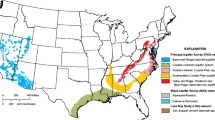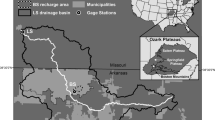Abstract
Three isolates of Escherichia coli were labeled by their resistance to sodium azide and, separately, to novobiocin, nalidixic acid, and tetracycline. The strains exhibited a high degree of persistence in the soil environment and were recoverable on strain specific media at levels within the 95% confidence interval of the numbers covered on nonselective media. The E. coli strains were subsequently used to evaluate the events which would occur when a septic tank drainfield became submerged in a perched water table and effluentborne bacteria escaped into the groundwater. Field experiments were conducted by introducing the strains into horizontal lines installed into the A, B, and C horizons of a soil profile and transport was evaluated by collecting groundwater samples from 5 rows of piezometers (sampling six separate depth zones/row) located downslope from the injection lines. The major portion of subsurface transport of the bacterial populations occurred in specific zones in the soil profile and at an apparent maximum velocity of 17.0 cm min−1. The maximum bacterial density in the groundwater, observed at each sampling distance downslope, was used to produce a mathematical relationship which described the overall decrease in numbers of organisms with increased distance through the soil. The potential health hazards which could occur by the subsurface transport of fecal organisms in relation to these experiments are discussed.
Similar content being viewed by others
References
Allen, M. J. and Geldreich, E. E.: 1975, Ground Water 13, 45.
American Public Health Association: 1975, Standard Methods for Examination of Water and Wastewater. 14th ed., American Public Health Association, Inc., New York.
Baker, F. G.: 1978, Water Resources Bulletin 14, 144.
Bissonnette, G. K., Jezeski, J. J., McFeters, G. A., and Stuart, D. G.: 1975, Appl. Microbiol. 29, 186.
Bouma, J., Zibell, W. A., Walker, W. G., Olcott, E G., McCoy, E., and Hole, F. D.: 1972, Wis. Geol. and Nat. Hist. Surv. Info. Circ., 20, 235 pp.
Craun, G. F.: 1978, Jour. WaterPoll. Control Fed. 50, 1362.
Craun, G. F., McCabe, L. J., and Hughes, J. M.: 1976, J. Am. Water Works Assoc. 68, 20.
Danso, S. K. A., Habte, M., and Alexander, M.: 1973, Can. J. Microbiol. 19, 1450.
Faust, M. A., Aotaky, A. E., and Hargadon, M. T.: 1975, Appl. Microbiol. 30, 800.
Geraghty, J. J. and Miller, D. W.: 1978, J. Am. Water Works Assoc. 70, 162.
Habte, M. and Alexander, M.: 1975, Appl. Microbiol. 29, 159.
Hagedorn, C., Hansen, D. T., and Simonson, G. H.: 1978, J. Environ. Qual. 7, 55.
Hammermeister, D.: 1978, Water and Anion Movement in Selected Soils of Western Oregon. Ph.D. Thesis, Oregon State University, Corvallis.
Klein, D. A. and Wu, S.: 1974, Appl. Microbiol. 24, 429.
McFeters, G. A. and Stuart, D. G.: 1972, Appl. Microbiol. 24, 805.
McFeters, G. A., Bissonnette, G. K., Jezeski, J., Thompson, C. A., and Stuart, D. G.: 1974, Appl. Microbiol. 27, 823.
Miles, A. A. and Misra, S. S.: 1938, J. Hyg. Camb. 38, 732.
Miller, J. H.: 1972, Experiments in Molecular Genetics, Cold Springs Harbor Laboratory, Cold Springs Harbor, N.Y.
National Academy of Sciences: 1977; Drinking Water and Health, National Academy of Sciences, Washington, D.C. pp. 63–88.
Rahe, T. M., Hagedorn, C., McCoy, E. L., and Fling, G. F.: 1978, J. Environ. Qual. 7(4), 487.
Reneau, R. B.: 1978, J. Environ. Qual. 7, 23.
Reneau, R. B. and Pettry, D. E.: 1975, J. Environ. Qual. 4, 41.
United States Environmental Protection Agency: 1973, Groundwater Pollution from Subsurface Excavations. U.S. Environmental Protection Agency, Washington, D.C. pp. 136–150.
Viraraghavan, T. and Warnock, R. G.: 1976, J. WaterPoll. Control. Fed. 48, 934.
Viraraghavan, T.: 1978, Water Air Soil Poll. 9, 355.
Ziebell, W. A., Nero, D. H., Deininger, J. H., and McCoy, E.: 1974, Proc. Nat. Home Sewage Disposal Symp. Am. Soc. Ag. Engin. Proc. 175, St. Joseph, MO. p. 58.
Author information
Authors and Affiliations
Additional information
For all correspondence.
Rights and permissions
About this article
Cite this article
McCoy, E.L., Hagedorn, C. Quantitatively tracing bacterial transport in saturated soil systems. Water Air Soil Pollut 11, 467–479 (1979). https://doi.org/10.1007/BF00283438
Received:
Revised:
Issue Date:
DOI: https://doi.org/10.1007/BF00283438




